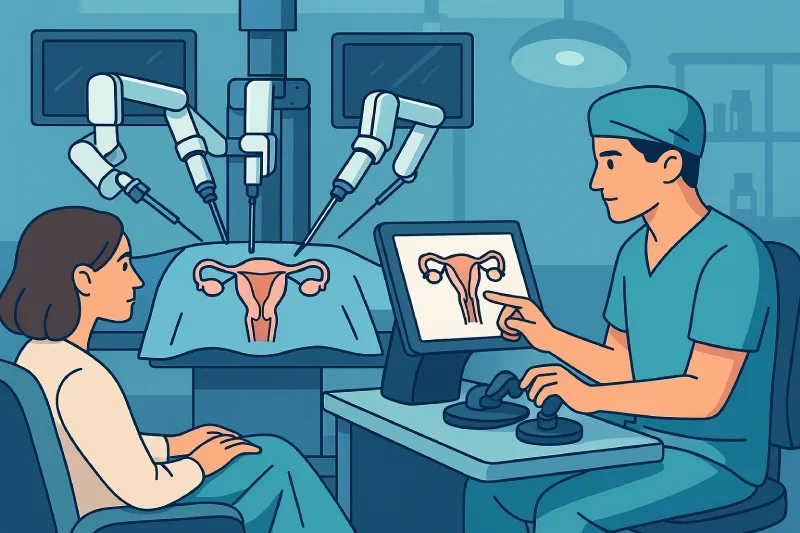Robotic Hysterectomy for Fibroids: Recovery, Benefits, and What to Expect
Categories:
By: Ethan Cole
Uterine fibroids affect many people, and when symptoms become severe, surgery may be recommended. Robotic hysterectomy is one of the most advanced surgical options available. This guide covers what the procedure involves, how it compares to other options, and what recovery looks like from day one to full return to normal activities.
Key Takeaways
Robotic hysterectomy provides faster recovery and less pain. Most patients resume light activities within two weeks, benefiting from shorter hospital stays, smaller scars, and overall improved outcomes compared to traditional open hysterectomy.
Surgical risks are minimized with robotic precision. While risks include bleeding, infection, and organ injury, careful patient selection and an experienced surgeon significantly reduce complications, making robotic-assisted hysterectomy safer for complex fibroid cases.
Fibroid size and number determine surgical approach. Robotic systems handle multiple fibroids and those up to 12 cm, though extremely large or numerous fibroids may still necessitate traditional open abdominal surgery.
Hormonal changes depend on ovary preservation. If ovaries remain intact, hormone levels and libido usually stay stable. When ovaries are removed, menopause symptoms may occur, sometimes requiring hormone replacement therapy for balance.
Robotic-assisted surgery ensures minimal scarring and quicker recovery. Small incisions lead to better cosmetic results, reduced blood loss, and faster healing, allowing patients to return to work and daily life sooner.
Long-term outcomes are generally positive with robotic hysterectomy. Most patients report improved quality of life, relief from fibroid symptoms, and low rates of complications, making it a highly effective minimally invasive surgical choice.
What Is a Robotic Hysterectomy?
Robotic hysterectomy is a type of minimally invasive surgery where a surgeon removes the uterus using robotic-assisted tools. It’s most often recommended when fibroids are large, numerous, or located in difficult-to-reach areas. This section breaks down what the procedure involves, why it’s used, and how the technology works.
Definition
A robotic hysterectomy is a surgical procedure that removes the uterus using robotic instruments controlled by a surgeon. It is typically performed through several small incisions in the abdomen. The robotic system translates the surgeon’s hand movements into precise, scaled movements of surgical instruments.
Purpose
Robotic hysterectomy is used to treat a range of gynecologic conditions, but it is especially helpful for fibroids. It allows for better visualization and precision when removing a uterus affected by large or numerous fibroids, particularly when traditional open or laparoscopic methods may be too invasive or risky.
Technology Explained
Robotic hysterectomy is performed using an advanced surgical system. The key components include:
Robotic Arms: Hold and maneuver surgical tools with stability and precision inside the patient’s body.
3D Camera: Provides a high-definition, magnified view of the surgical area for the surgeon.
Surgeon Console: Located nearby in the operating room, where the surgeon sits and controls the instruments and camera using hand and foot controls.
Why Choose Robotic Surgery for Fibroids?
Robotic surgery offers a less invasive option for removing fibroids and the uterus. This approach combines precision, control, and a quicker recovery process compared to traditional methods. In this section, we’ll look at what makes robotic surgery different, how it compares to other surgical options, and who might benefit the most.
Minimally Invasive Approach
Robotic hysterectomy is performed through small incisions, often less than an inch in size. This technique causes less trauma to surrounding tissues, which leads to less bleeding, reduced pain, and faster healing. Most patients go home the same day or after one overnight stay.
Comparison vs. Traditional Hysterectomy
|
Feature |
Robotic Surgery |
Traditional Open Surgery |
|
Incision Size |
Small (0.5–1 inch) |
Large (5–7 inches) |
|
Recovery Time |
2–4 weeks |
6–8 weeks |
|
Blood Loss |
Lower |
Higher |
|
Pain |
Less post-op pain |
More post-op pain |
|
Hospital Stay |
Same day or 1 night |
2–3 nights |
|
Precision |
High (robot-assisted) |
Standard (manual) |
|
Risk of Infection |
Lower |
Higher |
Ideal Candidates for Robotic Surgery
Robotic hysterectomy is often recommended for people who:
Have large or multiple fibroids
Have scar tissue from prior surgeries
Need a more precise procedure due to the fibroid’s location
Prefer a shorter recovery time
Want to reduce the risk of complications from open surgery
What to Expect Before the Procedure
Preparing for a robotic hysterectomy starts well before the day of surgery. This phase includes medical evaluations, lifestyle adjustments, and practical planning to help ensure a smooth experience and recovery. Here’s what you can expect during the preparation stage.
Pre-Operative Tests and Evaluation
Your doctor will review your medical history and conduct a physical exam. You may need imaging tests such as an ultrasound or MRI to assess the size and position of the fibroids, as outlined by the Mayo Clinic’s guidance on uterine fibroids.
Blood work is also common to check for anemia or other health issues. If you take medications regularly, these will be reviewed and possibly adjusted before surgery.
Fasting, Medications, and Preparation Tips
Before surgery, your care team will give you specific instructions. These often include:
Stop eating solid food at least 8 hours before surgery.
Drink only clear fluids up to 2 hours before the procedure.
Discontinue certain medications (like blood thinners or supplements) as directed.
Shower with antibacterial soap the night before or morning of surgery.
Arrange a ride home and help for the first few days after surgery.
Wear loose, comfortable clothing to the hospital.
Mental and Emotional Preparation
Surgery can be physically and emotionally demanding. It helps to ask questions, talk through concerns, and understand every step of the process. Knowing what to expect reduces anxiety and allows you to focus on healing. If fertility loss is part of the procedure, consider emotional support or counseling ahead of time.
What Happens During Robotic Hysterectomy Surgery
Understanding what takes place in the operating room can ease anxiety and help you feel more prepared. While every surgery is tailored to the patient’s needs, robotic hysterectomy follows a predictable series of steps involving precise tools and controlled movements.
Incision Placement and Instrument Setup
The surgeon begins by making several small incisions in the lower abdomen. Through these openings, ports are placed to hold the robotic instruments and a 3D camera. The abdomen is gently inflated with gas to create working space. Each tool is then carefully positioned for optimal access to the uterus.
Surgeon Control Console
The surgeon does not operate directly at the patient’s side. Instead, they sit at a console in the operating room and use hand and foot controls to move the robotic instruments. The camera provides a magnified view, allowing for exact movements that reduce trauma to nearby organs and tissues.
Surgical Duration and Anesthesia Use
The procedure typically lasts between two and four hours. This can vary depending on the size and number of fibroids, prior surgeries, or any unexpected complications. You will be under general anesthesia the entire time, which means you’ll be asleep and feel no pain during the procedure.
Complexity Factors
Some factors can affect how long the surgery takes or how it’s performed:
Large fibroids may require more time for safe removal.
High body mass index (BMI) can make instrument placement more challenging.
Scar tissue from previous surgeries may limit visibility or movement.
Pelvic anatomy variations may require surgical adjustments.
Recovery Timeline After Robotic Hysterectomy
Recovery from robotic hysterectomy is often quicker than with traditional open surgery, but it still takes time. Healing happens in phases, and knowing what to expect can help you plan for rest, activity, and emotional adjustment. Below is a breakdown of the typical recovery process.
Immediate Post-Op (First 24–48 Hours)
Most patients wake up in a recovery area with mild to moderate abdominal pain, cramping, and fatigue. You may feel groggy from anesthesia and could have a catheter in place temporarily. Nurses will monitor vital signs and help you begin walking as soon as it's safe—usually within hours. If no complications arise, discharge may happen the same day or after one night in the hospital.
First Week: Bleeding, Pain, and Activity Limits
Light vaginal bleeding is common for several days.
Mild to moderate pain can be managed with prescribed or over-the-counter medications.
Fatigue is expected and may come in waves.
No lifting anything heavier than 10 pounds.
Avoid driving until you're off pain medications and can move comfortably.
Short walks are encouraged to improve circulation and prevent blood clots.
Weeks 2–6: Healing, Energy Levels, and Return to Work
By the second week, discomfort typically decreases, and energy levels begin to rise. You can resume light activities, but still need to avoid strenuous movement. Most people return to work by week 3 or 4 if their job isn’t physically demanding. Full healing—including internal stitches—usually completes around week 6.
Emotional Recovery and Mental Health Considerations
Recovery isn’t just physical. Some people feel sadness, irritability, or emotional swings, especially if the surgery involved loss of fertility. Hormonal shifts may also play a role if the ovaries were removed. Give yourself space to rest and process, and don’t hesitate to talk to a counselor or support group if needed.
Benefits of Robotic Hysterectomy Over Open Surgery
Compared to traditional open hysterectomy, the robotic approach offers several clinical and practical advantages. These benefits are especially important for patients dealing with complex fibroid cases or looking for a faster recovery with fewer complications.
Reduced Blood Loss and Infection Risk
The robotic system allows for more controlled movements and better visualization, which leads to smaller blood vessels being cauterized more precisely. This means there’s less bleeding during surgery and a lower chance of needing a transfusion. Smaller incisions also reduce the risk of infection.
Minimal Scarring and Smaller Incisions
Instead of a single large cut, robotic surgery uses multiple small incisions. These are typically less than an inch long and placed in the lower abdomen. The cosmetic result is minimal scarring, and the incisions heal faster with fewer wound-related issues.
Shorter Hospital Stay and Faster Recovery
Most patients leave the hospital within 24 hours, and some go home the same day. The reduced trauma to the body results in less pain and a quicker return to everyday activities. Many patients resume light activity within a week and return to work within three to four weeks.
Enhanced Precision for Surgeons in Difficult Cases
The robotic system translates the surgeon’s movements into highly precise actions. This is particularly helpful when fibroids are large, located deep within the pelvis, or when scar tissue is present from prior surgeries. The improved dexterity and control lead to fewer complications and better outcomes in complex procedures.
Risks and Potential Complications
Robotic hysterectomy is considered safe, but like any surgery, it comes with some risks. Being informed about possible complications helps you recognize warning signs early and follow recovery instructions more closely. Most side effects are minor and manageable, while serious complications are rare.
Common Risks (Infection, Bleeding, Organ Injury)
Some of the most frequent risks include infection at the incision sites, minor bleeding during or after surgery, and accidental injury to nearby organs such as the bladder, bowel, or ureters. These are uncommon but possible, especially in complex cases where fibroids are large or scar tissue is present.
Rare Complications (Conversion to Open Surgery)
In rare cases, the surgeon may need to switch from robotic to open surgery during the procedure. This can happen if there is excessive bleeding, unexpected anatomy, or technical challenges. Although uncommon, your surgeon will discuss this possibility before the procedure.
How to Reduce Risks with Post-Op Instructions
Following post-operative care guidelines significantly lowers the chance of complications:
Keep the incision sites clean and dry
Avoid lifting heavy objects until cleared by your doctor
Take medications exactly as prescribed
Watch for signs of infection (fever, redness, unusual discharge)
Stay hydrated and eat a balanced diet to support healing
Walk daily to reduce the risk of blood clots
Attend all follow-up appointments
Final Thoughts: Is Robotic Hysterectomy Right for You?
Robotic hysterectomy offers a less invasive option for treating fibroids, with benefits that include faster recovery, reduced pain, and minimal scarring. It’s especially useful in cases where fibroids are large or located in hard-to-reach areas. Still, like any surgery, it comes with risks and should be considered alongside other treatment options.
The right choice depends on your health history, symptoms, and future goals—especially if fertility preservation is a concern. If you're considering robotic surgery, it's important to ask your provider detailed questions about the procedure, recovery, and long-term outcomes.
Schedule a consultation with Dr. Jason Neef, a board-certified gynecologic surgeon specializing in minimally invasive procedures. He’ll walk you through your choices and help you decide what’s best for your health and lifestyle.
Schedule your robotic hysterectomy consultation today.
Call (817) 568-8731Categories:
Frequently Asked Questions
-
Most patients stay less than 24 hours, often discharged the same day or after an overnight stay. The minimally invasive approach allows quick recovery and shorter hospitalization compared to open surgery.
-
Risks include bleeding, infection, injury to bladder, bowel, or urinary tract, vaginal cuff rupture, anesthesia complications, and rare conversion to open surgery. Careful patient selection and surgeon experience reduce risk.
-
Robotic hysterectomy recovery is faster, with less pain, smaller scars, and a 3-to-6-week healing period. Open surgery typically requires 6 to 8 weeks and involves more pain and longer hospital stays.
-
Robotic surgery can remove multiple fibroids, including large ones up to 10–12 cm in diameter, depending on surgeon skill and patient anatomy. Very large or numerous fibroids may require open surgery.
-
Sexual function usually improves after recovery, but hormone levels depend on ovary removal. If ovaries are preserved, hormones remain normal. Emotional and physical adjustments vary but often improve quality of life.
-
General anesthesia is used, allowing the patient to be unconscious and pain-free during the procedure, ensuring safety and comfort.
-
Avoid heavy lifting and strenuous exercise for 4–6 weeks. Walking and light activities are encouraged for circulation and healing.
-
Menstruation stops immediately after removal of the uterus, as there’s no place for menstrual blood to build up or exit.
-
Long-term side effects are rare but may include pelvic floor weakness or vaginal dryness, especially if ovaries are removed, impacting hormone levels.
-
Many patients resume desk work within 2 weeks; physically demanding jobs may require 4–6 weeks off for full recovery.











